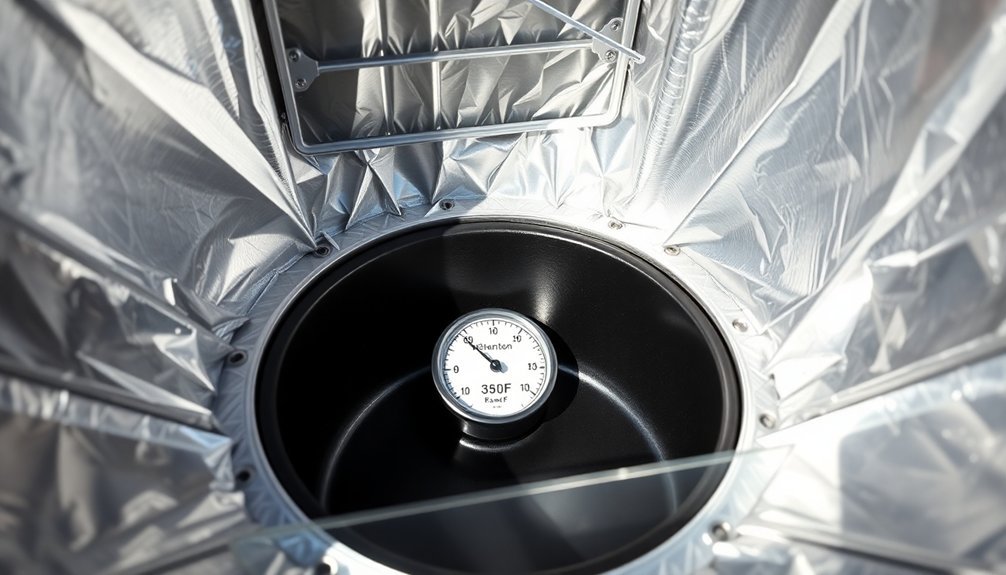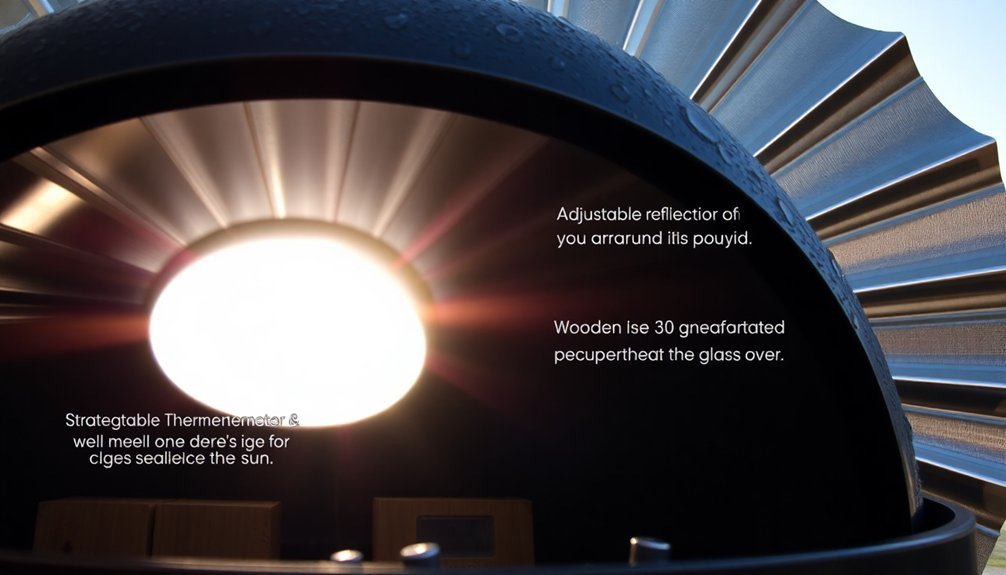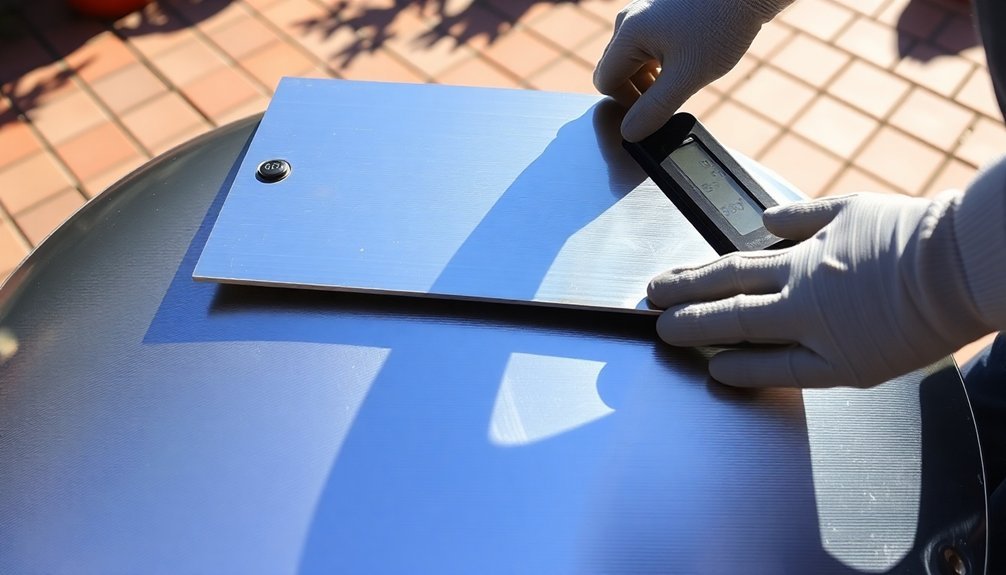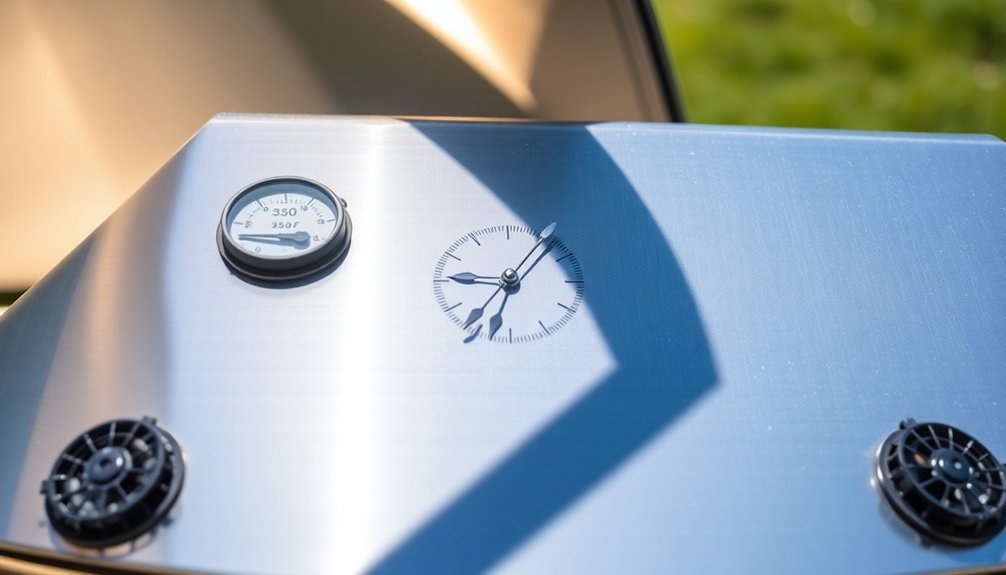Control your solar oven's heat effectively with these proven methods: Position your oven directly facing the sun and adjust it every 30-45 minutes for consistent temperatures. Use dark-colored, lidded cookware to maximize heat absorption and retention. Add multiple layers of insulation like crumpled newspaper or fiberglass around the cooking cavity. Install reflective panels strategically to direct additional sunlight onto your cooking surface. Monitor temperatures with a reliable thermometer, aiming for 150-225°F. While these basics will get you started, mastering advanced heat management techniques can elevate your solar cooking to professional levels.
Design Your Solar Oven

Every successful solar oven begins with careful attention to fundamental design principles. You'll need to incorporate two distinct bases to adapt to changing solar declinations throughout the year, ensuring ideal sun exposure regardless of the season.
Install four fixed mirrors to concentrate solar energy effectively, and include a transparent face that traps heat through the greenhouse effect. The transparent face allows visible and ultraviolet light to enter while preventing heat from escaping.
Create a box-within-box structure, with the inner box featuring a foil-covered shelf at the bottom for heat absorption. You'll want to attach the box lid using an aluminum tape hinge on one long edge, allowing for easy adjustments to capture maximum sunlight.
Cut a three-sided flap in the lid and cover it with aluminum foil to reflect sunlight into the cooking area.
For best heat retention, seal the box's opening with clear plastic wrap or heavy-duty cooking bags. Line the bottom with black construction paper and surround the cooking area with insulation materials like crumpled newspaper, dry leaves, or air spaces.
Use a ruler to adjust your reflector flap angle, ensuring proper sunlight concentration throughout the cooking process.
Position for Maximum Control
Three key factors determine your solar oven's effectiveness: orientation, positioning, and environmental conditions. To maximize heat control, you'll need to position your oven directly facing the sun, ensuring minimal shadows cast over the cooking area.
Adjust the reflective flap's angle using a ruler as a prop, and keep the oven's face perpendicular to the sun's rays.
Choose a clear, sunny day with consistent sunlight, and select a sheltered spot to protect your oven from wind interference. You'll want to monitor the temperature using a thermometer, ideally maintaining between 150-225°F. Most foods cook best during the peak hours of 10-4 in summer months.
As the sun moves, you'll need to reposition your oven every 30-45 minutes to maintain ideal heat collection.
Use dark-colored pots and cooking utensils to absorb more radiant energy, and enhance heat retention with insulation materials like crumpled newspapers and black construction paper.
Don't forget to protect yourself by wearing sunglasses when working with reflective surfaces. Keep the cooking pot closed to prevent heat loss, and avoid adding unnecessary water that could lead to moisture loss.
For precise temperature control, consider using a digital thermometer with a probe.
Managing Heat Efficiently

Managing your solar oven's heat efficiently requires a multi-layered approach to insulation and glazing. You'll need to surround your cooking cavity with effective insulating materials like crumpled newspaper, dry leaves, or spun fiberglass on all sides except the glazed surface. These materials work by trapping air particles, which substantially reduce heat transfer and help maintain higher cooking temperatures.
For best heat retention, use multiple layers of insulation and incorporate reflective surfaces like aluminum foil. Similar to natural building techniques, incorporating locally available materials for insulation can improve sustainability while maintaining thermal efficiency.
You'll want to make certain your glazing material – whether it's glass or heavy-duty plastic – is securely attached to prevent heat leakage. The glazing plays a vital role by allowing sunlight to enter while trapping the heat inside through the greenhouse effect.
To maximize efficiency, combine proper insulation with reflective panels that direct additional sunlight onto your cooking surface. Dark, heat-absorbing surfaces inside the oven and on your cookware will help capture more thermal energy.
Remember to maintain an air space between the window and food, as this creates an additional insulating layer that enhances your oven's overall performance.
Smart Solar Cooking Methods
Building on effective heat management, smart solar cooking methods elevate your control over temperature and cooking efficiency. You'll want to utilize dark, thin metal cookware with lids to maximize heat absorption while minimizing loss. By preheating your solar cooker and implementing real-time tracking through photoresistors and servo motors, you can maintain consistent temperatures throughout the cooking process. Experts recommend solar cooking experimentation to determine the optimal cooking times for different dishes.
| Strategy | Implementation |
|---|---|
| Temperature Monitoring | Use Type-K thermocouples for precise readings |
| Light Management | Deploy automated tracking with servo motors |
| Heat Optimization | Preheat cooker and use lidded dark cookware |
| Data Integration | Incorporate weather data and thermal modeling |
Take advantage of thermal modeling and data analysis to predict cooking times accurately. You'll need to think about weather conditions and adjust your cooking approach accordingly. The system's gimbal design allows for easy North-South rotation, while the parabolic shape concentrates sunlight effectively. When needed, implement manual adjustments for specific recipes. Keep track of your cooker's performance through real-time status updates, and use the integrated data visualization tools to monitor temperature patterns and optimize your cooking times.
Safety and Maintenance Essentials

Protecting safety and proper maintenance of your solar oven isn't just about performance – it's essential for safeguarding both you and your equipment.
You'll need to position your oven away from flammable materials and follow any local fire restrictions during dry conditions.
Always use heat-proof gloves when handling hot cookware, and maintain food safety by using a reliable thermometer to verify cooking temperatures above 140°F.
Don't let children operate the oven unsupervised, and keep food away from non-food-grade materials.
Your maintenance routine should include regular cleaning of reflective surfaces with a damp cloth and storing the oven in a protected location.
Line the inside walls with aluminum foil to maximize heat reflection and cooking efficiency.
Check frequently for damage to components, and wrap the oven in a protective covering when not in use.
Test the oven's performance regularly with a thermometer to guarantee it's working correctly.
Set up your oven in full sunlight between 11 a.m. and 3 p.m., adjusting its position as the sun moves.
Keep the oven and utensils sanitized to prevent cross-contamination.
You'll also want to maintain wooden components with varnish or oil and keep spare parts available for quick repairs.
Frequently Asked Questions
Can a Solar Oven Work on Cloudy or Overcast Days?
You'll find that standard solar ovens don't work well on cloudy days, but if you're using a heat retention model, you can still cook by storing energy from previous sunny periods.
How Long Does It Take to Preheat a Solar Oven?
You'll need about 20 minutes to preheat your solar oven to 300°F in strong sunlight. For best results, preheat empty for at least 30 minutes while keeping the oven aligned with the sun.
What's the Maximum Temperature a Solar Oven Can Typically Reach?
Your solar oven's maximum temperature depends on its type. You'll typically see parabolic cookers reach up to 700°F (371°C), while box cookers hit 400°F (204°C), and panel cookers achieve around 300°F (149°C).
Do Foods Cooked in Solar Ovens Taste Different From Conventionally Cooked Foods?
You'll notice that solar-cooked foods often taste better because they retain more moisture and natural flavors. The gentle, even heating preserves nutrients and brings out unique textures you won't get with conventional cooking.
Can Solar Ovens Be Used for Baking Bread and Desserts?
Yes, you can bake bread and desserts in solar ovens. You'll need to adjust cooking times, as they take longer than conventional ovens, but you'll get similar results with properly browned crusts and moist interiors.
In Summary
Control your solar oven's heat by implementing these proven methods in your outdoor cooking. You'll find that proper design, strategic positioning, and efficient heat management make all the difference in your results. Remember to follow smart cooking practices and maintain your solar oven regularly. With these techniques, you'll master temperature control and create delicious solar-cooked meals while harnessing the sun's power safely and effectively.





Leave a Reply